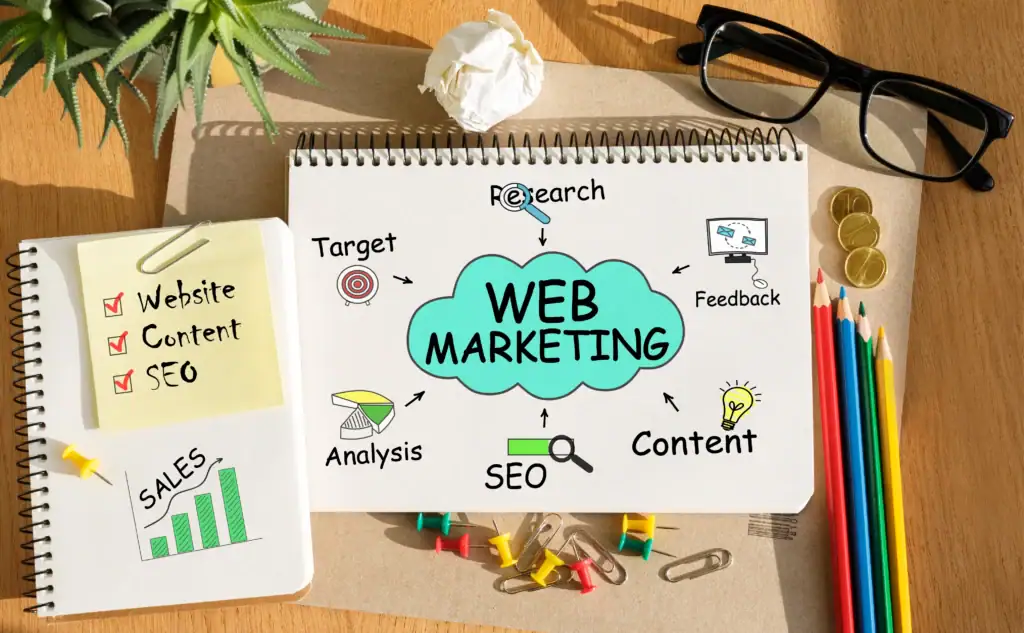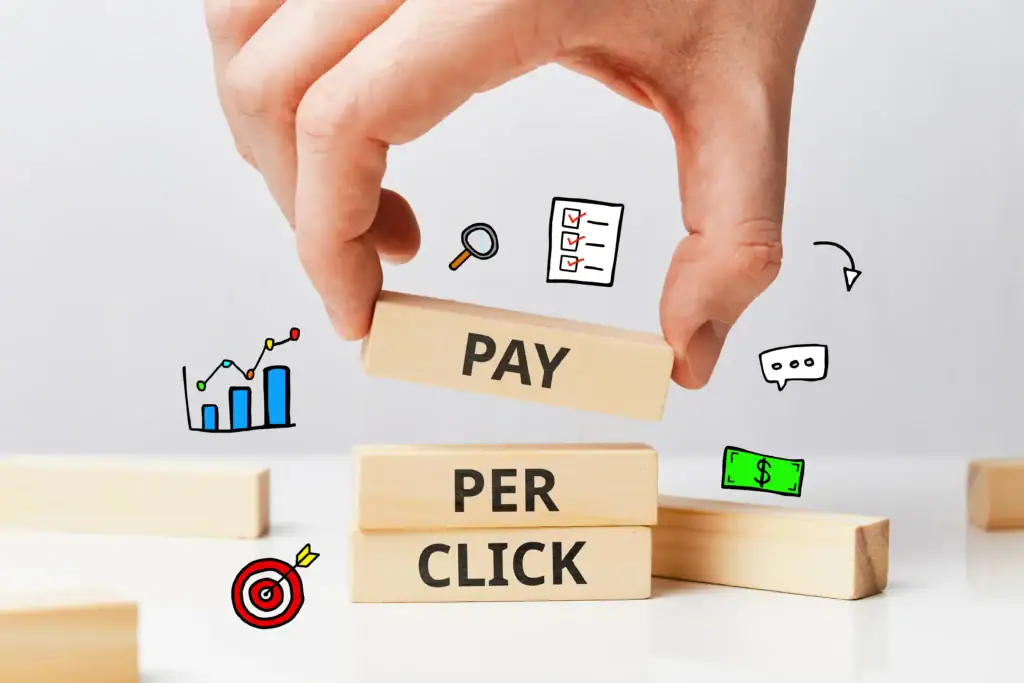Welcome to the universe of website marketing! Your website is the foundation of your online presence in the modern digital era. It’s not merely an electronic brochure; it’s your key conduit for reaching customers, presenting your brand, and fueling business development. This guide will take you through the basic steps to excel at website marketing. You will discover how to bring in the right visitors, hold their attention, and make your website an effective success engine.
Understanding Website Marketing

Before you can ever become proficient at website marketing, you first need to understand what it’s all about. It’s like the sum total of everything you do to market your site and get people who are actually interested in your services coming to visit. It’s a specialized aspect of the broader world of online marketing.
Successful marketing measures are intended to increase your site’s visibility and attract potential clients. In the parts below, we will discuss what web marketing is, how it is different from digital marketing, and why it’s increasingly important than before.
What Is Website Marketing?
Website marketing is the planned promotion of a site for bringing relevant traffic. The main objective is to bring people who may be interested in your firm’s products or services. In essence, more visitors to your site translate to more chances to expose your value proposition to potential customers and expand your business.
The practice includes a mix of strategies to boost your ranking in search engines such as Google. An effective marketing campaign will incorporate search engine optimization (SEO), blog content, and social media. The whole process centers on optimizing the user experience so that visitors hang around and browse.
Although it’s an important part of digital marketing, website marketing focuses directly on your site as the central hub. All promotional efforts are created to bring users back to your site, so it becomes the centerpiece of your online strategy.
Website Marketing vs. Digital Marketing
It’s easy to interchange “website marketing” and “digital marketing,” but they’re not synonymous. Digital marketing is the overall term that describes all online marketing efforts, from email campaigns and social media to mobile apps and search engine ads. It includes every interaction you have with a customer in the online space.
Web site marketing, in contrast, is a particular niche of digital marketing. Its aim is one and only: directing qualified traffic straight to your website. While a digital marketing strategy could encompass a billboard (a type of traditional marketing with a QR code), a web site marketing strategy would concentrate on methods such as content marketing and SEO to drive users to a particular landing page.
Imagine it this way: online marketing is the whole orchestra, and website marketing is the string section. It is an important component of the overall performance but a single part of the overall symphony.
Why Is Website Marketing Essential in 2026?
In 2026, a vibrant online presence is no longer a choice—it’s survival and growth. Your website is the hub of your brand’s digital presence, and website marketing is the fuel that keeps it going. Without strategic promotion, even the most well-designed website won’t receive the visitors.
Effective marketing efforts allow you to differentiate yourself in a busy online marketplace. The objective is to drive brand exposure and be at or near the top of search engine listings, which having more directly correlates to increased website traffic. More traffic means more chance to enhance conversion rates, that is, making a sale, capturing a lead, or acquiring a newsletter subscriber.
And here’s why it’s so important:
And here’s why it’s so important:
- Increased Market Share: It allows you to gain new customers and increase your business’s share of the market.
- Higher SERP Ranking: First-page pages on Google receive more than 50% of traffic for target keywords.
- Customer Connection: It’s a main way to get connected with your audience and share your brand’s value proposition.
Setting Clear Goals for Website Marketing

To develop a successful web marketing strategy, you require a definitive destination. Goals provide direction and context to your efforts. Without them, you’re flying blind. Begin by defining your target audience and what you’re attempting to accomplish, be it creating brand awareness or enhancing lead generation.
Now that you know your audience and your goals, you can establish measurable objectives. That means you choose key performance measures (KPIs) to monitor your progress and keep your strategy on track.
Finding Your Target Audience
Knowing whom you are attempting to connect with is the key to successful website marketing. Who are your potential clients? What are their pain points, needs, and challenges? By answering these questions, you can identify your target market and map your content strategy to appeal to them.
Developing detailed buyer personas can be invaluable. They are semi-fictional portraits of your target customers from market studies and actual data. By understanding their objectives and motivations, you can develop content that is specifically targeted to meet their needs, making your marketing efforts much more productive for lead generation.
Defining SMART Objectives
Now that you understand your audience, the time has arrived to define clear, actionable objectives. One of the most effective best practices for doing this is the SMART objectives framework. It makes your objectives Specific, Measurable, Achievable, Relevant, and Time-based. This format eliminates confusion and gives you a crystal-clear success standard.
For instance, instead of a general objective such as “boost website traffic,” a SMART goal would be: “Boost organic website traffic by 20% within the next six months by posting two fresh blog posts per week.” This is specific, measurable (20% boost), attainable, relevant to business expansion, and has a definite deadline.
Having SMART objectives in mind aids in specifying your marketing efforts and monitoring what is effective. It enables you to quantify your progress toward expanding conversion rates, attracting better leads, and eventually establishing proof of return on investment.
Choosing Key Performance Indicators (KPIs)
How will you recognize that your marketing campaign is successful? That is where key performance indicators (KPIs) fit in. KPIs are quantifiable values that reflect how well you are meeting your business goals. They offer tangible data to represent what’s good and what’s bad.
Metrics like these need to be tracked using tools such as Google Analytics. You can track everything from site traffic overall to how a particular landing page is performing. Let’s say you are trying to generate leads, and you would monitor the conversion rate of your contact form. If it’s brand awareness that you’re trying to generate, you might monitor direct traffic over time.
Typical KPIs to measure are conversion rates, qualified lead volume, and growth in organic traffic. By regularly checking these metrics, you can make informed decisions to maximize your marketing efforts and know you are on the path to achieving your objectives.
Building a Solid Website Foundation

Your website is the cornerstone of your whole online venture. If that corner is unstable, all your traffic-building efforts may collapse. Before you even consider getting traffic, you must make sure that your site gives an amazing user experience to every visitor on your site.
That is, prioritizing clean and intuitive website design, making sure that your site is perfectly functional on mobile, and optimized for speed. A well-constructed site not only engages your visitors but also communicates quality to search engines, which can make all the difference for your rankings.
Building a User-Friendly Design
A clean and intuitive website design is necessary for retaining visitors. If your site is difficult to understand or complicated to use, individuals will exit and never return. Your aim is to provide a smooth user experience that points visitors in the direction of the information they’re looking for and the actions you want them to perform.
Consider your site from a visitor’s point of view. Is navigation straightforward? Is copy readable? Are calls to action (CTAs) visible? A good user experience hack is to have a consistent design that aligns with your brand and content strategy.
A couple of real steps to consider:
- Intuitive Navigation: Structure your site in a logical way with obvious menus and labels.
- Consistent Branding: Ensure that the same fonts, colors, and brand voice are used on every page.
- Clear CTAs: Make it clear what you are asking users to do next, either “Buy Now” or “Learn More.”
Mobile Optimization Strategies
With more individuals searching the internet on their phones than ever, it’s not negotiable – mobile optimization is essential. Most of your web site visitors are probably mobile users, and if your site is not presenting well on their phones, you’re giving them a subpar experience and losing business.
Google currently indexes and ranks websites using their mobile versions, and this is referred to as mobile-first indexing. Your search engine ranking will be affected if your site is not mobile-friendly. Responsive design that automatically adapts to any screen size is the norm for contemporary websites.
Quick loading time is also important for mobile optimization. Users on mobile expect fast-loading pages, and when pages take long to load, they result in high bounce rates. Optimizing images and leveraging the latest web technologies are important considerations to ensure your site loads fast for all users, regardless of the device.
Improving Site Speed and Performance
Site speed is an important consideration for both user experience and search engine rankings. A slow website annoys users and makes them leave your site before your content loads. Page performance is even a recognized ranking signal by Google Search, which means a quicker site will get you further up in the rankings.
There are numerous reasons why a website can be slowed down, from big, unoptimized images to bulky code. One of the best practices is to test your site speed periodically with free tools such as Google’s PageSpeed Insights. These tools will pinpoint certain problems that are damaging your page performance.
To optimize your site speed, try compressing images, code minification, and browser caching. These technical enhancements make a lot more difference for your users, bounce rates decrease, and all these help positively in your SEO endeavors. Having a fast website is an essential step toward creating a successful online presence.
Developing Your Website’s Brand

Your website represents the online face of your business, so having a great brand identity is important. Branding is more than a logo; it’s about the vibe and message you intend to promote to your audience. A consistent brand contributes to recognition and trust, both elements which are important to having a successful online presence.
By building a memorable brand identity and employing consistent messaging, you can enhance the perception of your brand and enhance brand visibility in all your marketing channels. It assists you in differentiating yourself from your competitors and creating a loyal base of customers.
Building a Memorable Brand Identity
Your brand identity is all the things that your business generates to project the proper image to its buyer. This encompasses your logo, color scheme, type, and tone of voice. A good brand identity makes you memorable and leaves a lasting impression. Consider how Apple’s simple design instantly comes to mind; that’s the strength of good branding.
Your site ought to be the epitome of your brand. Each page, from the site’s homepage to your business profile, must always portray your identity. This has to be carried over to all of your marketing materials, such as your content marketing campaigns and posts on social media platforms.
When your brand identity is well defined and consistent, it creates brand awareness organically. Customers come to recognize your visual aesthetic and tone with your business, forming a closer connection and building brand loyalty in the long run.
Taking Advantage of Consistent Messaging Across Channels
Consistent messaging is the way to create a powerful, recognizable brand. Your brand’s tone of voice, core values, and key messages must be consistent whether a customer is reading your blog, viewing a posting on social media sites, or getting an e-mail from you. Trust is established, and your brand identity is reinforced through consistency.
Imagine if your website is professional and serious, but your social media is full of casual memes. This disconnect can confuse your audience and weaken your brand’s credibility. An effective content strategy ensures that all your marketing strategies align and communicate a unified message.
For any company to do business online, this consistency is essential. It allows your customers to have the same experience regardless of where they engage with your brand and know what you believe in. Such a unified strategy will help establish your credibility and increase the effectiveness of your marketing campaign.
Building Trust and Authority Online
In the online space, trust is a currency. Clients are likely to conduct business with companies they trust and perceive as credible experts within their industry. Establishing this trust requires time and regular effort, but it is vital for long-term success.
The best method to establish trust is through the display of social proof, including customer reviews and online reviews. Testimonials from satisfied customers are third-party confirmations that assure potential customers. Sharing valuable content that teaches and assists your audience is another effective method of establishing credibility.
In addition, tactics such as influencer marketing can further hasten this process. If a reputable influencer promotes your brand, they impart their trust and credibility to you. All these activities together create a solid reputation online that not only brings in loyal customers but also retains them.
Essential Website Marketing Strategies for Traffic Growth

After your website core is established and your brand is established, it’s time to concentrate on expansion. The next move is to introduce digital marketing strategies that will drive web traffic. The objective is to bring in visitors that are actively seeking the solutions you offer.
The most sustainable form of growth is organic search, or you don’t pay for every click. This entails becoming a master of search engine optimization (SEO), content marketing, and exploiting the power of social media in order to drive a consistent flow of traffic to your site.
Mastering Search Engine Optimization (SEO)
Search engine optimization, or SEO, is the work of making your site more discoverable and attractive to search engines such as Google Search. Properly executed SEO will improve your site’s position in the search results, generating a consistent stream of organic traffic from individuals actively searching for your offerings or services.
SEO is a combination of on-page and off-page strategies. On-page SEO concentrates on optimizing things on your website, whereas off-page SEO is about acquiring authority by means of backlinks from other authoritative websites. Effective keyword research is the cornerstone of any effective SEO campaign as it will familiarize you with the words that your users use.
Most essential parts of a contemporary SEO campaign are:
- Technical SEO: Making sure your website is fast, secure, and crawlable for search engines.
- On-Page SEO: Producing quality content with keyword optimization for related keywords.
- Off-Page SEO: Developing backlinks from authoritative websites to establish your site’s authority.
Utilizing Content Marketing
Content marketing is an approach aimed at generating and distributing valuable, relevant, and consistent content to attract and retain a clearly defined audience. Unlike direct advertising, content marketing gives your visitors instant value in the shape of knowledge, insights, or entertainment, which is why some describe it as the only kind of marketing remaining.
To make people remain on your website, you require quality content. Your site content, such as blog articles, articles, and guides, is where you get to address your audience’s queries and position your brand as a specialist. That leaves them trusting you and interested in your stuff.
The most effective content marketing campaigns are built around a core asset, such as a detailed eBook. From there, marketers can craft an ongoing campaign of blog posts and social media posts to promote the asset and drive leads. With regular, relevant content, you provide people with a reason to visit your site and return for more.
Harnessing the Power of Social Media
Social media marketing is an effective means of driving traffic to your site and communicating with your audience. With billions of active users on different social media platforms, it’s an avenue you can’t afford to overlook. It’s a great vehicle for distributing your content and bringing people back to your website.
Your social media activities should be a extension of your content marketing program. Post your new blog articles, case studies, and even entertaining, relevant material to drive customers to click. The tip is to post content that people want to read, and therefore go to your website to find out more.
Different social media channels appeal to different audiences, so it’s important to choose the platforms where your target customers are most active. Whether it’s Facebook, LinkedIn, or TikTok, a consistent presence on the right social media channels can significantly drive traffic and build a loyal community around your brand.
Paid Marketing Methods to Drive Results

Organic methods are wonderful for long-term development, but every now and then you require an instant boost. Paid marketing techniques are able to send targeted traffic and immediate results. These strategies, a major component of search engine marketing, entail the payment for ad space on sites such as Google or social media.
Operating a paid advertising campaign on sites such as Google Ads is very effective, particularly when employed to supplement your other activities. These techniques enable you to target audiences specifically and guide them to your site, enabling you to reach your objectives sooner.
Introduction to Pay-Per-Click (PPC) Advertising
Pay-per-click (PPC) advertising is a model in which you pay per click on one of your ads. The most widely used PPC platform is Google Ads, in which you can place ads at the top of search results. It is an effective means to drive targeted traffic to your website from users actively searching for what you have to offer.
The greatest benefit of PPC is that it targets. You can target users based on demographics, location, keywords, and so on. This will display your ad in front of people who are likely to be the most interested, thus higher conversion rates.
To maximize the use of PPC, it’s wise to utilize it in conjunction with other marketing strategies.
- Direct to a Landing Page: Take users directly to a landing page that is specific to a specific action.
- Targeted Appeals: Design specific ads that cater to various audience needs.
- Promote Content: Promote valuable content such as blog posts or eBooks through ads to drive leads.
Exploring Social Media Ad Platforms
Social media advertising is another force to be reckoned with in paid digital marketing. Facebook, Instagram, and LinkedIn provide heavy-duty advertising capabilities that enable you to target highly granular audiences. With billions of daily users, these social media platforms are rich terrain for discovering new customers.
The power of social media marketing is in the granularity of the targeting options. You can target according to users’ interests, behavior, demographics, and even connections. This kind of granularity lets you drive very targeted, qualified traffic to your site, maximizing the chances of conversion.
Either you are a B2B business employing LinkedIn to attract professionals or a B2C business employing Instagram to attract shoppers, social media ads are adjustable to suit your objectives. They are hard to miss since they’re shown right in the newsfeeds and stories of users, so they’re a powerful method for grabbing attention.
Retargeting and Remarketing Strategies
What do people who visit your site and bounce off without converting do? Retargeting and remarketing are methods for bringing them back. What these strategies do is display targeted ads to people who have previously visited your website as they surf elsewhere on the web.
This style of advertising campaign is effective due to the fact that it is targeting a “warm” audience—ones who already know you. Viewing your ads repeatedly acts as a friendly reminder, keeping your business on their mind and making them go back and finish a purchase or fill out a form.
Networks such as Google Ads and Facebook Ads provide robust retargeting capabilities. By presenting relevant ads to the people who visited your site before, you can greatly improve conversion rates. It’s an economical method of re-engaging prospects and funnel them deeper into the sales process.
Local and Niche Website Marketing

If your business is based online and targets a local geographic area, local marketing efforts are necessary. Competing with the national giants online can be challenging for local businesses. That’s where other niche strategies and local SEO come in, assisting you in reaching customers in your area.
By concentrating on local search, monitoring your online reviews, and being present on community platforms, you can put your business in front of the individuals who are most likely to be your customers. These locally targeted efforts are important for service-based companies and brick-and-mortar businesses.
Optimizing for Local SEO
Local SEO refers to a collection of procedures that make your business rank on local search results. When your local area user searches for a service you provide, you want your business at the top of the list. Small businesses that count on local clientele would be especially concerned with this.
One of the strongest local SEO tools is Google My Business (GMB). An optimized and filled-out GMB listing gives searchers your contact information, hours, and location. It also shows online reviews, which are essential to establishing trust, as 88% of consumers read them to decide on the quality of a local business.
Google displays search results from a user’s location in order to offer the most specific information. By optimizing your site for local search keywords (such as “plumber in Brooklyn”) and having a robust GMB presence, you will have the potential to greatly boost your visibility in local search results.
Getting Listed on Online Directories
In addition to Google My Business, having your business listed in other applicable online directories is an easy and surefire way to increase brand exposure. The directories, including Yelp, Yellow Pages, and specific industry websites, are another potential source of new customers.
Consistency is crucial. Make your business profile—name, address, phone number, and website—the same everywhere. Misinformation will confuse customers and search engines alike and might damage your local search rankings.
Listing on these sites has some advantages:
- Greater Visibility: You are visible in more locations where customers are searching.
- SEO Bonus: Each listing generates a citation, which is a local SEO ranking factor.
- More Traffic: Directories provide another source of referral traffic to your website.
Engaging with Community Platforms
For any online business, especially local businesses, engaging with online communities can be a great way to connect with potential customers. Platforms like Reddit, Quora, or local Facebook groups are places where people ask questions and discuss their pain points. This is your opportunity to step in and help.
Rather than outright selling your company, use your content to deliver real, useful content. Respond to questions about your field and lead with useful advice. For instance, a plumber might post advice on an online community forum for how to avoid frozen pipes in winter.
This method makes you a useful expert and one that can be trusted. When the users perceive you as a trusted source of information, they’re more likely to remember your business when they require a product or service. You may naturally refer to your business or link to a related blog post on your website where necessary.
Tools for Effective Website Marketing Management

Keeping all the moving pieces of a digital marketing strategy straight can be daunting. Fortunately, numerous tools exist that can help you monitor your efforts, measure results, and optimize your content strategy. These tools give you the information you need to make educated decisions.
From analytical tools such as Google Analytics to content management systems, the appropriate technology can make your workflow more efficient and your marketing much more effective. Let us consider some of the major tools that can assist you in monitoring your success.
Analytical Tools to Monitor Success
In order to know whether your marketing campaign is doing the trick or not, you must measure everything. You require analytical tools for monitoring website traffic, visitor behavior, and your general campaign success. Google Analytics is a free powerful tool that must be at the center of all your tracking activities. It provides you with the information about who comes to your site, why they came there, and what they do when they get there.
In addition to overall analytics, there are also other tools to assist you with certain aspects of your marketing, such as search engine optimization. Tools such as SEMrush and Ahrefs give you keyword rank data, backlink information, and competitor data, so you can view how you rank in search results. Checking these metrics regularly allows you to spot opportunities and improve your strategy.
Here are some helpful tools for managing your campaigns:
| Tool Category | Example Tools | Primary Use |
| Web Analytics | Google Analytics | Tracking website traffic, user behavior, and conversions. |
| SEO | SEMrush, Ahrefs | Keyword research, rank tracking, and competitor analysis. |
| Social Media | Buffer, Hootsuite | Scheduling posts and analyzing social media performance. |
| Email Marketing | Mailchimp, Constant Contact | Managing email campaigns and tracking open/click rates. |
Common Website Marketing Mistakes to Avoid

As you create your presence online, it’s simple to have a couple of slip-ups along the way. Being aware of common marketing missteps can steer you away from them and keep your strategy on course. Quite a few of these mistakes have to do with forgetting the basics, such as user experience or content quality.
By understanding these pitfalls, you can make sure that your efforts are worth it. Let’s take a look at some of the most common mistakes that can backfire on your website marketing, so you avoid them.
Ignoring Mobile Users
One of the largest marketing blunders that a company can commit nowadays is neglecting mobile users. Since mobile devices represent most of the organic traffic, not offering a sound mobile experience is equivalent to closing your door to most of your prospects.
Most visitors to your site will be using smartphones to browse, and if your site is slow, unreadable, and hard to use on a small screen, they will abandon you. This not only means lost business but also damages your search rank, as Google gives preference to sites that are mobile-friendly.
Adhering to mobile optimization best practices isn’t merely a technical effort; it’s an integral aspect of delivering a good user experience for all visitors. A responsive layout that scales across every screen size is no longer a nice-to-have; it’s a flat necessity for any modern website.
Neglecting Website Analytics
Another frequent trap is ignoring website analytics. Lots of businesses put time and money into marketing but don’t monitor the outcome. Without statistics, you won’t have any idea what’s successful, what’s not, and where your budget should be allocated.
Resources such as Google Analytics offer masses of information about your online enterprise. You can observe which channels are producing the most traffic, which landing page experiences the highest bounce rate, and how users are navigating through your site. Disregarding this information is akin to flying blind.
By monitoring your website analytics on a consistent basis, you can gauge the return on investment, find new opportunities, and make informed data-driven decisions to improve your campaigns. Not doing so means you’re most likely wasting money and missing opportunities to enhance your performance.
Overlooking Content Quality
In the haste to generate content, it’s simple to compromise on quality. Yet ignoring content quality is a huge blunder. Publishing “fluff” or low-quality content simply to get something fresh into your blog posts will cause more harm than good. People visit your site searching for answers and insights, not pitches.
If your content is neither valuable, relevant, nor engaging, your visitors will immediately leave. This raises your bounce rate and tells search engines that your website is not a helpful resource. Better content, however, engages visitors on your site longer, convinces them, and proves your authority.
Focus on developing great content that actually benefits your readers. Each article or post should be well-written, well-researched, and offer substantial takeaways. Quality will always beat quantity when it comes to engaging and retaining a loyal following.
Conclusion
In summary, dominating website marketing is essential to succeed online. It is through comprehending the significance of laying a strong foundation, establishing clear objectives, and using effective measures that your site can gain significant traction in terms of exposure and interaction. Always use SEO, content marketing, and social media but steer clear of pitfalls such as ignoring mobile users and neglecting analytics. As you start your website marketing journey, remain flexible and always update your strategy according to performance reports. Whether you’re ready to scale your website marketing activities, don’t hesitate to contact for professional advice or a complimentary consultation. Your journey towards increased online visibility begins here!
Frequently Asked Questions
What are the best online marketing tactics for small businesses?
For small businesses, the most effective website marketing tactics tend to concentrate on local influence. Getting your Google My Business listing optimized is critical for local search engine optimization. Developing valuable content with content marketing and interacting with customers on social media are also inexpensive methods to foster brand visibility and bring in local clients.
How do I develop a website marketing strategy for organic growth?
To develop an organic growth marketing plan, begin by conducting keyword research to learn what your visitors are looking for. Develop your SEO plan and content plan around these keywords. Regular publication of great, optimized content is the key to getting sustainable organic traffic in the long run.
What tools will assist me in managing website marketing campaigns?
There are a number of tools that can aid in the management of digital marketing initiatives. Google Analytics is necessary for monitoring traffic as well as conversions. SEMrush is useful for your content marketing strategy and SEO, whereas Mailchimp is excellent to use for your email campaign management. These tools offer data used to measure and optimize your marketing campaigns.





